Human history is littered with people who changed the world, only to have their achievements erased from popular memory. Gay men like computing pioneer Alan Turing, women like mathematician Ada Lovelace, even pure oddballs like Nikola Tesla were left out the curriculum for decades. Thankfully, this is no longer the case. On the internet, everyone from the Navajo code talkers, to NASA’s black, female number crunchers are having their stories told.
But what if we told you that there’s a name still missing from their ranks, one that should be on everyone’s lips. The name of a female mathematician so influential her work may be second only to that of Albert Einstein. Her name was Emmy Noether, and her work changed history.
Born into a German-Jewish family in the late 19th Century, Noether grew up in a world designed to reject people like her. Barred from attending university due to her gender, she nonetheless managed to attain a grasp of mathematics so phenomenal that her work created an entire discipline. Anonymous in her lifetime, ignored by posterity, this is the life of Emmy Noether, the most-important mathematician the world forgot.
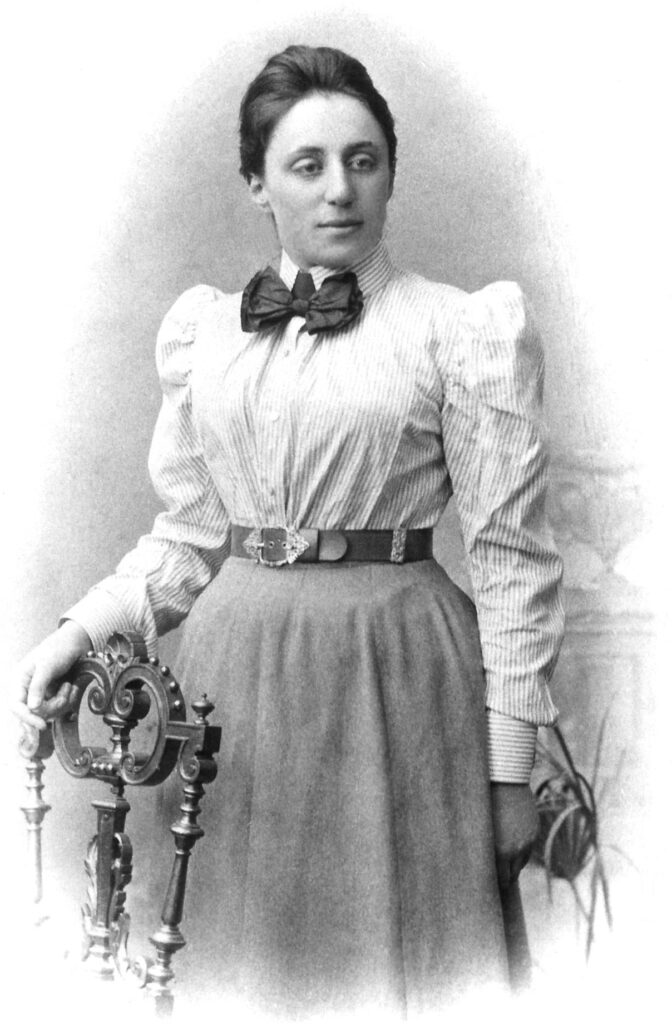
Nice Girls Don’t Do Math
When Emmy Noether was born on 23 March, 1882, it was into a family that was almost designed to produce geniuses. Her father, Max Noether, was a highly-respected mathematician attached to Erlangen University. Her mother came from the wealthy Kaufmann family of Cologne.
Although Emmy was the eldest, her brother Fritz would become almost as famous a mathematician as their father. In short, this was a family of wealthy brainboxes, intimately connected to a very prestigious university. With such an upbringing, how could Noether not succeed?
Yet this outward advantage masked a less-privileged reality.
The Noethers were Jewish. Max’s ancestors had changed their names to try and blend in with German society. But while Germany in the late 19th Century was much less anti-Semitic than it would become, the first traces of poisonous racism were already there.
Although Noether’s Jewishness would turn her into a target later in life, it wasn’t solely what made her early years difficult.
No, that was Nother’s bad luck to be born female.
We say “bad luck” not to rile up female viewers, but because it really was a disadvantage back then. While as a very young girl Noether was desperate to follow her father into mathematics, society at the time was all kinda like “Pfft, girls can’t do math. Learn the piano instead.”
Noether’s childhood may not have been fulfilling, but at least she was happy. At elementary school, her teachers noted that she was always laughing. In fact, happiness seems to have been Noether’s default setting throughout her life.
She spent her childhood dancing to made up songs, telling jokes, and getting highly excited about anything that grabbed her fancy. Yet there were also signs of something deeper at work. As she entered her teens, Noether began spending longer amounts of time lost in her own head, like she was distracted by a voice only she could hear.
Already, it seems she was spending more time puzzling out reality than she was living in it.
But puzzles weren’t for nice girls, so Noether spent her day to day life training to be a language teacher. She did a pretty good job, too. When she took the teaching exam in 1900, she received the second-highest possible grade.
But Emmy Noether would never do even an hour of paid language teaching in her life.
That same year, 1900, Noether seems to have decided to Hell with what society wanted. She applied to study math at Erlangen University. At the dawn of the 20th Century, women were forbidden from attending University classes in Germany. At least, they were officially.
Unofficially, professors were given leeway over who they allowed to sit in on lectures.
This was something of an advantage if, oh I dunno, your dad just happened to be a respected math professor at the university you wanted to attend. Not long after, Noether began sitting in on Erlangen’s math courses, one of only two women in the entire university.
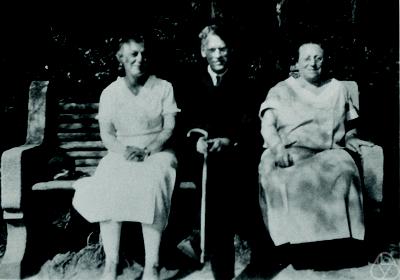
For the next two years, she progressed so quickly that, when she sat an equivalent exam in 1903, she passed with flying colors. Had she been male, Noether would’ve doubtless now found herself riding a rocketship to the very heights of academia.
But unfortunately her double X chromosome disqualified her from doing anything remotely fulfilling, so instead she went to Göttingen University to sit in on yet more classes.
However, Noether’s winter stint in Göttingen would turn out to be a blessing in disguise.
While there, she studied under David Hilbert and Felix Klein, two of the most distinguished mathematicians in Germany. Neither of the three geniuses knew it in 1903, but they were just over a decade away from a collaboration that would change the world.
A Time of Change
In spring, 1904 the German government suddenly dropped a bombshell. From the following semester onward, women would be allowed to enroll at the empire’s universities.
For Noether, this was like spending your entire life standing on the sidelines at a dance, only to suddenly be invited to join in – although admittedly in this metaphor “dancing” involves a whole lot more algebra than usual.
Anyway, Noether raced back to Erlangen and, on October 24, sat her entrance exam.
Did she pass? Of course she did.
That year, 1904, Noether officially joined one of the first mixed-sex math courses in Germany. Remarkably, she doesn’t seem to have encountered any real resentment. While it likely existed in some form, most of her professors seem to have realized she had a gift for the subject.
Three years after joining, on Friday, 13 December, 1907, Noether took the examination for her Phd. She passed so handily that she graduated with the highest honors possible.
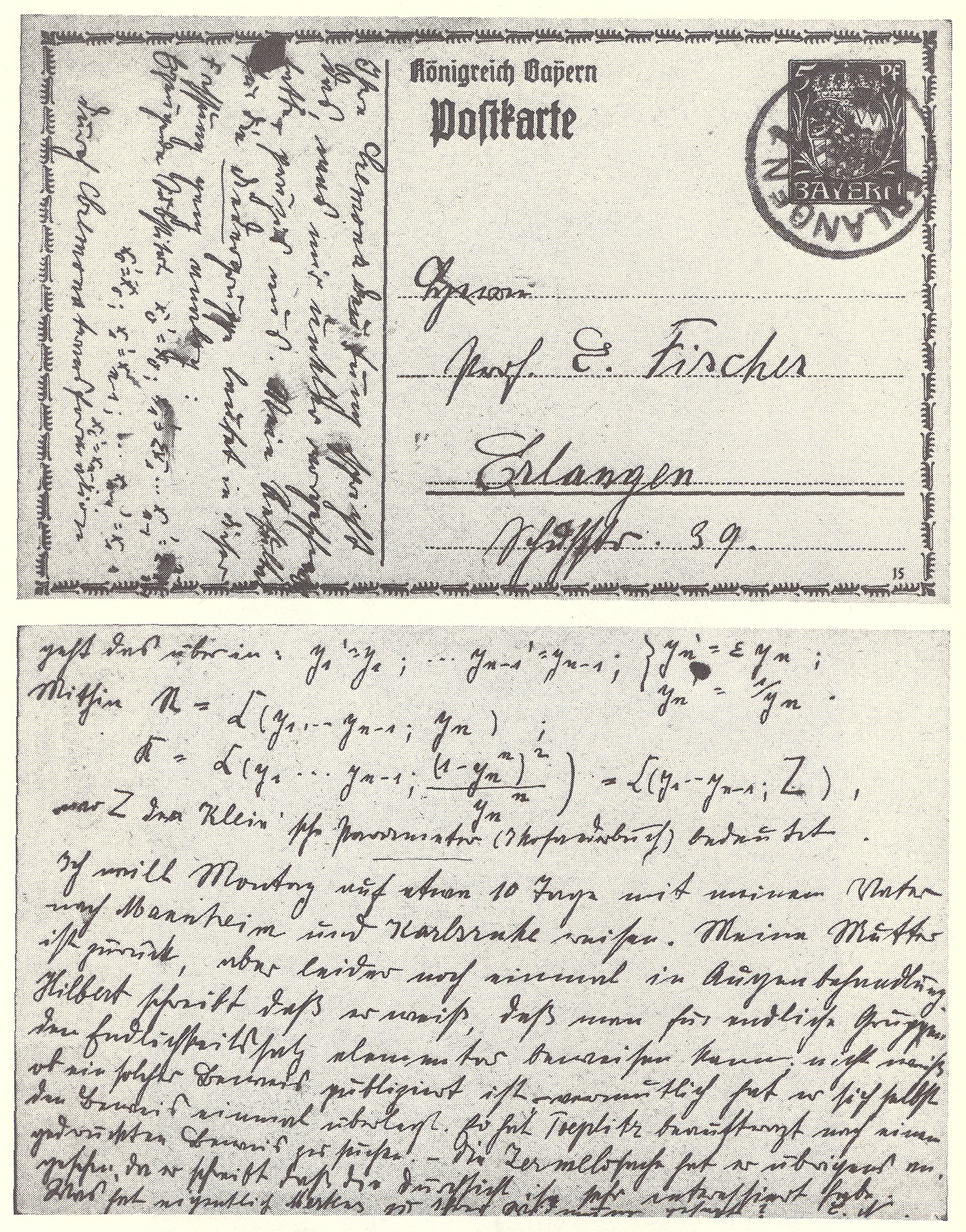
To return to our earlier metaphor, this moment is Noether dancing so spectacularly the entire hall stops to watch. It’s also the moment some asshole janitor snaps the lights back on and brings the whole dream to an abrupt end.
Although Noether had a Phd in math, she wasn’t actually allowed to do anything with it. The law thought women should be able to study, but not lecture. So Noether found herself in possession of a brilliant mind and a stellar education, but absolutely nothing she could do with either of them.
Still, she did have a couple of aces up her sleeve.
The first was her mother’s money. Thanks to her family, Noether didn’t have to get a job. If she wanted to, she could devote her time to the unpaid study of math.
The second ace was her father.
By 1908, Max Noether was suffering more and more from a disability brought on by childhood polio. He needed more time off, and a substitute who could cover him when he couldn’t attend class. A substitute just like Emmy.
Subbing for her dad was an unpaid role, but one which allowed Noether to remain in Erlangen. To keep on studying, to keep publishing papers. The more she worked, the more notice she got. In 1909, for example, Noether was invited to go to Salzburg, to address the German Mathematical Society.
In 1911, she came to the attention of Ernst Sigismund Fischer, who championed her work at Erlangen and sparked her own interest in abstract math. By 1915, shortly after the outbreak of WWI, she was even overseeing two of her father’s Phd students, advising them on their doctoral theses.
It’s entirely possible she could have gone on like that forever. Kept right on working away in Erlangen, perhaps eventually even making it onto the salaried staff. But 1915 was the year that everything was gonna change, both in mathematics and in Noether’s personal life.
That’s because 1915 was the year that a former patent clerk named Albert Einstein blew up the entire scientific world. Einstein’s Theory of General Relativity was the most transformative event in math since Newton decided to discovery gravity and save us all from a lifetime of weightlessness.
It turned almost everything we thought we knew on its head, and lit a fire under the asses of every math department on the planet.
Among those with suddenly burning backsides were Emmy’s old mentors David Hilbert and Felix Klein. That same year, the two identified what appeared to be a problem in Einstein’s theory, one that seemed to imply Einstein’s work contradicted laws on the conservation of energy.
But the two of them alone weren’t up to the task of figuring out all the implications. What they needed was a fresh set of eyes. Someone with expertise in invariant theory. Not long after, Noether got a call asking her to come back to Göttingen.
She said yes.
Einstein’s Dreams
When Noether arrived in Göttingen that year, it’s fair to say the all-male faculty wasn’t pleased to see her. Hilbert’s plan had originally been to have Noether appointed associate professor. To which some long-forgotten stuffy German-dude replied:
“What will our soldiers think when they return to the university and find that they are required to learn at the feet of a woman?”
Hilbert retorted:
“I do not see that the sex of the candidate is an argument against her. After all, we are a university, not a bathhouse.”
But, in the end, stuffy German dude carried the day, and Hilbert was forced to give Noether the unpaid position of “guest lecturer”.
At which point Noether showed everyone up by solving the problem with Einstein’s work in, like, fifteen minutes. It turned out that the problem wasn’t actually a problem. Hilbert and Klein had just been thinking too small. Using Einstein’s work, Noether was able to prove that energy would indeed be conserved across a sufficiently large patch of space.
But it was what she discovered alongside that, that made Noether’s name. That became the reason she deserves to be remembered.
Noether’s Theorem would change the world.
OK, we’re gonna level with you here: we read a ton of articles trying to get our heads around Noether’s Theorem so we could explain it to you, but it turns out it’s super confusing to people – like us – whose primary job is history and who usually respond to the word “algebra” with a bloodcurdling scream.
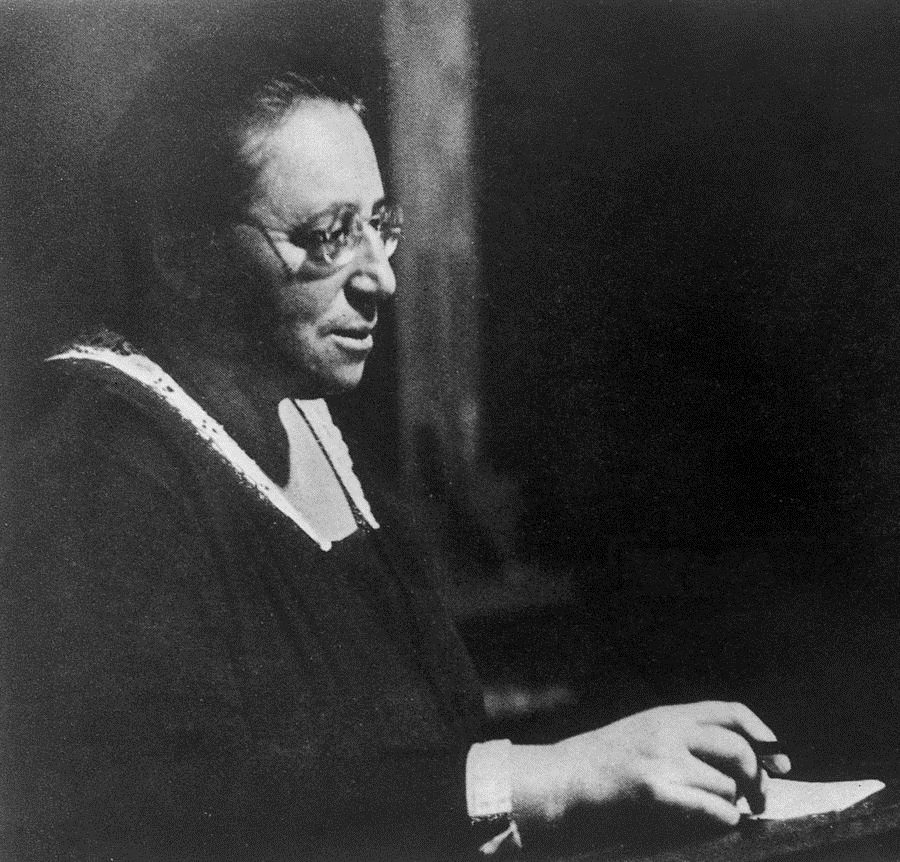
So we’ll let an expert do the talking, in this case the New York Times’s Pulitzer Prize-winning science journalist, Natalie Angier:
“What the revolutionary theorem says, in cartoon essence,” she wrote, “is the following: Wherever you find some sort of symmetry in nature, some predictability or homogeneity of parts, you’ll find lurking in the background a corresponding conservation — of momentum, electric charge, energy or the like…”
For example, “Noether’s theorem shows that a symmetry of time — like the fact that whether you throw a ball in the air tomorrow or make the same toss next week will have no effect on the ball’s trajectory — is directly related to the conservation of energy.”
Got that? Throwing balls, conservation of energy, relativity solved. Err, sure?
Still, even mathematical luddites like us can appreciate the historical significance of Noether’s work.
Her Theorem would go on to hugely influence a new generation of scientists working in the 1950s and 1960s. Scientists who used her work to predict the existence of new particles. One of those was the Higgs Boson, the so-called God Particle discovered in 2012.
Take away Emmy Noether and her Theorem, and the cutting edge of physics today suddenly looks very different. Unfortunately, there was a major barrier to most people actually hearing about Noether’s discovery.
During WWI, scientists working for the Central Powers were forbidden from sharing discoveries with rival nations, in case it lead to a military breakthrough.
But one person did get to hear about Emmy’s work.
After reading of Noether’s Theorem, Einstein wrote to Hilbert. In his letter, he used a simple term to describe the woman who’d come up with it.
He called her a genius.
The New Germany
The next few years of Noether’s life were odd, to say the least. Although she’d just made a major breakthrough, most of the world didn’t know about it.
On top of that, the university was still refusing to pay her and, with the German economy shattered by war, even money from her parents wasn’t enough to stop her sliding into poverty. At least she was able to continue working. During this period, Hilbert managed to get around the university’s prohibition on solo female lecturers by advertising Noether’s classes in his own name and then “forgetting” to show up.
It wasn’t much, but it allowed Noether to follow her passion.
Then end of the war brought its own problems, as Germany plunged into chaos at the end of 1918, a chaos that only ended in August, 1919, with the creation of the Weimar Republic. With the era of upheaval at an end, Noether and Hilbert fixed their sights on a new target.
Getting Noether a real job at Göttingen University.

By now, she’d been able to publish her Theorem to a wider audience. Everyone knew she was a mathematician of staggering talent. But, no. The stuffy German dudes on the university’s board had somehow missed the whole “discovering a world changing theorem” bit, and remained intensely un-keen on lady lecturers.
They maintained this position all the way through 1921, even as Noether published her paper Idealtheorie in Ringbereichen, now seen as a major milestone in the advent of modern algebra. Finally, in 1922, the university condescendingly awarded the cleverest person in their midst with a role as untenured associate math professor, and allotted her a pitifully small salary.
It was a victory, sort of, but the stuffy Germans were dicks enough to make sure it didn’t feel like one.
Yet Noether doesn’t seem to have really cared.
She was able to teach now, to work on her passion. She became one of the most popular lecturers on campus, with a dedicated student clique forming around her known as “the Noether Boys”.
Yep: boys. Despite the law change and Noether’s presence, there were almost zero women studying math at Göttingen. And that reflected the deeper attitudes that were still swirling around at the time.
In 1927, for example, Noether began a collaboration on non-communicative algebras with two male mathematicians, but was only rarely able to put her name on the papers.
Still, the community itself championed her.
In 1928, for example, she was invited to address the International Congress of Mathematicians at Bologna. In 1929 she was briefly given the job of visiting professor at Moscow university. As time passed, signs slowly began to appear that things were, indeed, changing.
In 1930, Noether met the 24-year old Czech math superstar Olga Taussky. After, she told her friends how pleased she was that women were finally being accepted in math. Yet while acceptance might have been growing where Noether’s gender was concerned, an even more violent wave of oppression was about to come crashing down on her.
Noether was a prominent Jewish woman living in 1930s Germany.
Unfortunately, we all know what’s coming next.
The Age of Horror
The same year that Noether met Olga Taussky, the Weimar Republic held one of its frequent elections. But while every previous election had returned messy, but expected results, the election of September, 1930 returned an unpleasant surprise.
From one of the smallest parties in the Reichstag, the Nazis were catapulted into second place, netting nearly a fifth of the vote. The era of Weimar democracy was reaching its end. Around the corner lurked a time of unspeakable horror.
The coming nightmare wasn’t immediately apparent in Göttingen, especially for the apolitical Noether.
Oh, sure, a couple of her students started turning up to her lectures wearing Nazi brownshirts, but Noether laughed it off.
She knew these boys. She knew they would never harm her. The next couple of years were accompanied by the steady drumbeat of jackboots and despair.
In October, 1930, the SA undertook its first major anti-Jewish action, destroying storefronts in Berlin. Two years later, Weimar Germany again went to the polls, this time giving the Nazis the largest number of seats and over 37% of the vote.
Yet Noether still didn’t realize the danger she was in. The same year that the Weimar Republic teetered on the edge of annihilation, she was accepting awards for her math work and addressing international congresses in Switzerland.
But her ignorance couldn’t last.
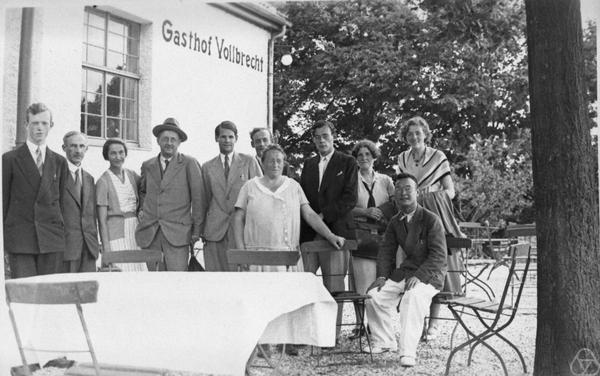
On January 30, 1933, Hitler was made Chancellor of Germany, a momentous event celebrated nationwide by torchlit SA and SS parades through cities. Not three months later, on March 24, the Reichstag passed the Enabling Act, handing Hitler absolute power.
The very next month, Noether was fired from Göttingen for being Jewish.
It was almost like someone had been waiting for an excuse to get rid of her. Noether was given no compensation for the loss of her job, denied a pension, and told she would be unable to teach again. The mathematician’s response was impressively upbeat. Noether wrote to a friend:
“I must say, though, that this thing is much less terrible for me than it is for many others. At least I have a small inheritance (I was never entitled to a pension anyway) which allows me to sit back for a while and see.”
And that’s exactly what she did.
Through the summer of 1933, Noether continued to teach in private, opening up the front room of her home to any students who wanted to learn math. She even allowed her brownshirt students to attend these informal classes, ignoring the fact that these boys had likely marched through the city chanting Nazi slogans just a few months earlier.
As a friend of Noether’s later noted, she never “doubted (the brownshirt students) integrity”. This was about math. Politics could be damned. Thankfully, Noether never got to experience the true faces of her Nazi students.
That fall, worried about Noether’s increasingly precarious position, Albert Einstein arranged for her a job lecturing at Bryn Mawr College in Pennsylvania. Remarkably, she turned him down. If she was going to emigrate, she wanted to go to England to teach at Oxford, not some American college.
But it soon became apparent that she didn’t have a choice.
Across 1933, the Nazis passed a raft of anti-Semitic laws, excluding Jews from many professions, and subordinating all Jewish intellectual output to Goebbels himself. Although physical violence against Jews wouldn’t become state policy until 1935, it was clear now even to the optimistic Noether which way the wind was blowing.
That October, Noether boarded a boat bound for the USA. Not long after, she began her visiting professorship at Bryn Mawr.
With remarkable luck, Noether had just escaped the clutches of one of the most-destructive, racist regimes of all time. Although she would return to Germany once more, she would never again be victimized by Nazi policies.
Unfortunately, her escape would only turn out to be a reprive. Nobody knew it yet, but the fifty one year old Noether was only 18 months away from the end of her life.
Death and Legacy
When death finally came for Noether, it was with a suddenness that was painfully unfair. Across 1934, Noether had settled into her new life in America. She’d begun additional lectures at Princeton, and built a small but devoted following in both universities.
In fact, it was in America that she probably felt the most accepted she ever had in her life. No-one in the States seemed to care that she was a woman who wanted to teach math. That she was Jewish. Finally, after half a century, Noether had found somewhere that seemed to accept her for who she was. Somewhere she could live out the rest of her life without trouble.
She even felt comfortable enough to take a trip back to Germany that year. While riding on the Hamburg metro with her brother, she struck up an excited conversation about Idealtheorie – a mathematical concept that in German uses the term “Führer”.
Her brother’s wife would later remark that Noether seemed completely oblivious to how close she came to being arrested for that discussion. As 1935 dawned, Noether was ensconced in Pennsylvania, working on her theories, and seemingly enjoying a new lease of life.
And then she got the news.
On April 8, doctors discovered Noether had an ovarian cyst. They recommended her for surgery and, on April 10, she went under the knife. As they operated, the doctors made a gruesome discovery. Noether’s insides were riddled with tumors. The great mathematician was dying.
But death wouldn’t even have the decency to wait another couple of months. Four days after her surgery, on April 14, 1935, Noether developed a sudden, extreme fever. An infection had developed. The doctors rushed to save her, but they were too late.
Emmy Noether died that same afternoon. At the time she passed away, she’d only just turned 53.
Today, her name is all but forgotten outside of math and science circles. Even some who know her theorem know nothing about her. They may even assume the “Noether” it’s named after was male.
And this is a tragedy, because her work changed the world. A whole lot of modern theoretical physics is underpinned by her ideas, and her contributions to abstract algebra were so huge that we’ve seen people claim she basically invented the discipline.
The weirdest part of all this, is that people knew how special she was. After Noether died, Albert Einstein wrote in the New York Times:
“In the judgment of the most competent living mathematicians, Fräulein Noether was the most significant creative mathematical genius thus far produced since the higher education of women began.”
Yet while Einstein remains a household name, while Kepler, Cantor, and John Nash all trigger hints of recognition, Noether’s name has slipped into the fog. The most significant thinker the world somehow forgot.
But we shouldn’t be too sad for Noether. While she certainly deserves more recognition, it can’t be denied that her work lives on, influencing millions of thinkers, helping us to understand the universe.
She may have slipped into obscurity today, but when the final sum total of the human race is added up, and the achievements of all the billions and billions who have ever lived are weighed…
…it’s comforting to know that Emmy Noether will be up there at the very top, still smiling away; the mathematician who changed the world.
Sources:
Britannica overview: https://www.britannica.com/biography/Emmy-Noether
Very detailed biography from the History of Mathematics website: http://mathshistory.st-andrews.ac.uk/Biographies/Noether_Emmy.html
Who she is, why you should know her: https://www.nytimes.com/2012/03/27/science/emmy-noether-the-most-significant-mathematician-youve-never-heard-of.html
Her life and work (in a simplified form): https://www.vox.com/2015/3/23/8274777/emmy-noether
Noether’s Theorem: https://www.discovermagazine.com/the-sciences/how-mathematician-emmy-noethers-theorem-changed-physics
Two short videos explaining, and simplifying, Noether’s Theorem: https://www.youtube.com/watch?v=ahf0zCaqrwM



